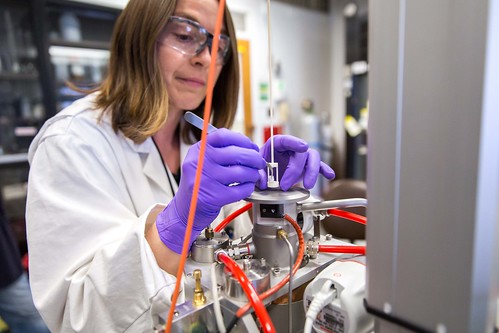
Potholes are a growing problem in the US and UK, worsened by climate change exacerbating freeze/thaw. How should we fix them? CC-licensed photo by Alan Stanton on Flickr.
You can sign up to receive each day’s Start Up post by email. You’ll need to click a confirmation link, so no spam.
There’s another post coming this week at the Social Warming Substack on Friday at 0845 UK time. Free signup.
A selection of 9 links for you. Take it slowly. I’m @charlesarthur on Twitter. On Threads: charles_arthur. On Mastodon: https://newsie.social/@charlesarthur. Observations and links welcome.
Apple warns proposed UK law will affect software updates around the world • Ars Technica
Ashley Belanger:
»
Apple is “deeply concerned” that proposed changes to a United Kingdom law could give the UK government unprecedented power to “secretly veto” privacy and security updates to its products and services, the tech giant said in a statement provided to Ars.
If passed, potentially this spring, the amendments to the UK’s Investigatory Powers Act (IPA) could deprive not just UK users, but all users globally of important new privacy and security features, Apple warned.
“Protecting our users’ privacy and the security of their data is at the very heart of everything we do at Apple,” Apple said. “We’re deeply concerned the proposed amendments” to the IPA “now before Parliament place users’ privacy and security at risk.”
The IPA was initially passed in 2016 to ensure that UK officials had lawful access to user data to investigate crimes like child sexual exploitation or terrorism. Proposed amendments were announced last November, after a review showed that the “Act has not been immune to changes in technology over the last six years” and “there is a risk that some of these technological changes have had a negative effect on law enforcement and intelligence services’ capabilities.”
The proposed amendments require that any company that fields government data requests must notify UK officials of any updates they planned to make that could restrict the UK government’s access to this data, including any updates impacting users outside the UK.
UK officials said that this would “help the UK anticipate the risk to public safety posed by the rolling out of technology by multinational companies that precludes lawful access to data. This will reduce the risk of the most serious offenses such as child sexual exploitation and abuse or terrorism going undetected.”
«
The amendment is presently chugging through the Lords. Let’s hope it just runs out of Parliamentary time like all the other poorly thought-through ideas of this government.
unique link to this extract
Climate change is causing a pothole plague. Are robots and self-healing pavement the solution? • BBC Future
Mia Taylor:
»
In 2023, there were nearly 630,000 reports of potholes in the UK, which marked a five-year high, according to data compiled by campaign group Round Our Way. In the United States, meanwhile, about 44 million drivers reported damage to their vehicles from potholes in 2022, which was a massive 57% increase over 2021, according to AAA.
While ageing infrastructure and limited road maintenance budgets play a significant role in the problem, another culprit behind the marked proliferation of potholes is severe weather brought about by climate change, which is weakening roads.
“There are a number of issues caused by climate change that are impacting roads,” says Hassan Davani, an associate professor in San Diego State University’s department of civil, construction, and environmental engineering. “Excessive heat can ultimately cause buckling of the roads, where additional thermal stress to the pavement materials can lead to cracks and potholes. We’re also experiencing more extreme flooding events, which causes a higher velocity of stream flow over the roads, resulting in more severe erosion of the pavement.”
Another contributing factor is the increased number of freeze and thaw cycles taking place each year as climate change worsens, which is also undermining road conditions.
With more freezing and thawing comes more frost heaves impacting roads. “Frost heaves are ice lenses that form in underlying layers of the road. When they melt during the spring thaw, the moisture is trapped and that’s a big part of the issue causing the formation of potholes,” adds Jo Sias, a professor of civil and environmental engineering at the University of New Hampshire.
«
The solutions, in the story, are fascinating – though who knew about “ice lenses” before this? Not me, for sure.
unique link to this extract
New ransomware reporting requirements kick in as victims increasingly avoid paying • Coveware
»
In Q4 2023, the average ransom payment decreased to $568,705 (-33% from Q3 2023), whereas the median ransom payment stabilized and remained at $200,000 (no change from Q3 2023). The trend aligned with a relative decline in the size of victims impacted (discussed further in this report), and a reappearance of small game actors groups who reclaimed some market share after previously dropping in frequency during Q3.
The proportion of ransomware victims that opted to pay ransoms in Q4 2023 dropped to a record low margin of 29%. This data point is driven by several variables: (1) Continued resiliency growth in enterprise environments; companies impacted by ransomware are increasingly able to recover from incidents partially or fully without the use of a decryption tool. (2) Data driven reluctance to pay for intangible promises from cybercriminals, such as the promise not to publish/misuse stolen data and the promise to exempt the company from future attacks or harassment; the industry continues to get smarter on what can and cannot be reasonably obtained with a ransom payment. This has led to better guidance to victims and fewer payments for intangible assurances.
Echoing the sentiment above, we observed a decrease in the volume of data-exfiltration-only payments. Q4 was rife with examples of how data assurances can fail, even when interacting with well-known “brand established” ransomware groups. These cautionary tales have allowed us to offer timely and detailed examples to other companies of why threat actors cannot be trusted to prevent ongoing misuse/publication of stolen data, and why payments to them for these imaginary assurances have zero if not sub-zero value.
«
So organisations are getting better at having backups so ransomware doesn’t affect them as badly, and discount claims by hackers about publishing sensitive data; as a result ransomware payout numbers as a proportion are falling fast. But as a total number? Not clear, though the suspicion has to be that it’s still growing. Plenty of fish in the sea.
unique link to this extract
New lithium discoveries can secure America’s clean energy future • The National Interest
Joseph Bouchard:
»
On November 28, 2023, the US Department of Energy confirmed its discovery of a 3,400-kiloton reserve of lithium in California’s Salton Sea, making it one of the largest exploitable lithium deposits in the world.
In August, American volcanologists and geologists found a large lithium deposit in Nevada’s ancient McDermitt Caldera volcano, which could produce between 20,000 and 40,000 kilotons. If fully exploited, both deposits would be sufficient to fulfill the world’s lithium needs many times over.
Besides minor grants provided to the researchers and companies who discovered these two immense lithium deposits, no efforts have been made to develop the technology, capacity, and infrastructure necessary to exploit these two deposits. These incredible discoveries should be a wake-up call for American investors and lawmakers to stop investing in foreign, unreliable partners and begin an ambitious project to exploit the lithium reserves here at home.
Currently, the US is almost entirely dependent on foreign countries for all lithium extraction, manufacturing, and production. The largest exploitable lithium reserves are in South America’s Lithium Triangle, which comprises Bolivia, Chile, and Argentina. While Chile has been a productive ally of the US, Bolivia and Argentina have faced enormous economic, political, and geopolitical barriers to production.
…After extraction, most of the world’s raw lithium is then transported to China, which has over half of the world’s lithium refining capacity. While the US has talked a big game about boosting domestic critical mineral production, it has increased its imports of lithium products from China, including lithium batteries used in electric vehicles and specialized electronics.
«
So the US needs to get mining, and it needs to get refining. Seems straightforward enough.
unique link to this extract
Texas just broke a record for how much power it got from the sun • KUT Radio, Austin
Mose Buchele:
»
Solar energy provided more power to Texas than ever before on Sunday morning, generating more than one third of the electricity on the state’s grid. Experts say it’s a Texas record that’s not expected to last very long – because it will soon be broken again.
Weather conditions were ideal for solar, with clear skies across most of the state, when the Electric Reliability Council of Texas recorded the record at 10:09 a.m. Sunday.
At that time, about 15,222 megawatts of solar ran over Texas transmission lines to homes and businesses. According to ERCOT, one megawatt can power 200 homes in times of peak energy use.
Later that day, Texas broke a record for the share of electricity on the grid that comes from the sun: 36.11%.
Joshua Rhodes, an energy researcher at UT Austin, said he thinks the state will be breaking more records in the near future “as we install more [solar facilities] and the sun’s higher in the sky during the summer.”
Rhodes said the new record is the result of recent years of meteoric growth in solar installations in Texas, which recently surpassed California as the state that produces the most energy from solar power.
«
Of course Texas’s administrators hate renewables, and think oil is the most splendiferous, because oil has concentrated ownership which means personal lobbying and political donations. Solar is smaller and decentralised; and the figure above doesn’t even include microgeneration from rooftop solar.
unique link to this extract
Signs of ‘transmissible’ Alzheimer’s seen in people who received growth hormone • Nature
»
Researchers say they have uncovered more evidence to support a controversial hypothesis that sticky proteins that are a signature of Alzheimer’s disease can be ‘transmitted’ from person to person through certain surgical procedures.
The authors and other scientists stress that the research is based on a small number of people and is related to medical practices that are no longer used. The study does not suggest that forms of dementia such as Alzheimer’s disease can be contagious.
Still, “we’d like to take precautions going forward to reduce even those rare cases occurring”, says neurologist John Collinge at University College London who led the research, which was published1 in Nature Medicine on 29 January.
For the past decade, Collinge and his team have studied people in the United Kingdom who in childhood received growth hormone derived from the pituitary glands of cadavers to treat medical conditions including short stature. The latest study finds that, decades later, some of these people developed signs of early-onset dementia. The dementia symptoms, such as memory and language problems, were diagnosed clinically and in some patients appeared alongside plaques of the sticky protein amyloid-beta in the brain, a hallmark of Alzheimer’s disease. The authors suggest that this amyloid protein, which was present in the hormone preparations, was ‘seeded’ in the brains and caused the damage.
«
I first came across Collinge back in 1996, when I started covering the crossover of BSE in cows to variant CJD in humans. He had already been working for years on what came to be recognised (as BSE and vCJD are) as prion disease, where a common protein which can take two different shapes (one good, one bad) switches to the “bad” one and triggers a cascade in the brain. And now he’s finding the same effect around Alzheimers.
unique link to this extract
Apple Vision Pro review: magic, until it’s not • The Verge
Nilay Patel:
»
the Vision Pro also represents a series of really big tradeoffs — tradeoffs that are impossible to ignore. Some of those tradeoffs are very tangible: getting all this tech in a headset means there’s a lot of weight on your face, so Apple chose to use an external battery pack connected by a cable. But there are other, more philosophical tradeoffs as well.
As I’ve been using it for the past few days, I kept coming up with a series of questions — questions about whether the tradeoffs were worth it.
• Is using the Vision Pro so good that I’m willing to mess up my hair every time I put it on?
• Is it so good that I want to lug it around in its giant carrying case instead of my laptop bag?
• Is it so good that I want to look at the world around me through screens instead of with my own eyes?Basically, I keep asking if I prefer using a computer in there rather than out here. And as interesting as the Vision Pro is, there’s a long way to go before it can beat out here.
…Watching movies on the Vision Pro is a ton of fun, especially in the Apple TV app’s immersive movie theater that lets you pick where you want to sit. It’s also very cool to watch a movie in one of Apple’s virtual environments like Mount Hood and see the colors from the screen reflect onto the landscape or look around one of the Disney Plus environments like Avengers Tower. And movies themselves look great — the incredible quality of the Vision Pro’s displays is really obvious when you’re watching something. I watched far more of Top Gun: Maverick than I intended to just because it looked so good blown up to drive-in movie size, floating over a mountain.
Since the Vision Pro sends separate images to each eye, it can do true 3D movies — and Apple and its partners like Disney have already released quite a few. If you have a large Apple movie library, you get the 3D versions for free — you just choose 2D or 3D playback when you hit play. Apple is also making immersive versions of some of its Apple TV Plus shows, which basically means a 180ish-degree 3D video that feels like the best Google Cardboard demo of all time. I watched someone walk a tightrope in Adventure, and it was very convincing — but if you’ve never tried this before, I’d be careful that you get used to VR motion before diving into 3D videos. Apple has also promised immersive sports content, but sadly, I wasn’t able to try any of that yet.
«
This is very long, but I feel like these elements form the nut of it.
unique link to this extract
Apple has sold approximately 200,000 Vision Pro headsets • MacRumors
Juli Clover:
»
Apple has sold upwards of 200,000 Vision Pro headsets, MacRumors has learned from a source with knowledge of Apple’s sales numbers. Apple began accepting pre-orders for the Vision Pro on January 19, so the headset has been available for purchase in the U.S. for 10 days.
Last Monday, Apple analyst Ming-Chi Kuo claimed that Apple had sold an estimated 160,000 to 180,000 Vision Pro units during the pre-order weekend for the device, so sales may have slowed somewhat since then.
Vision Pro headsets for launch day home delivery sold out within hours of pre-orders launching, and in-store pickup options followed shortly after, so it is no surprise that interest in the headset has started to wane somewhat after the initial rush of orders.
Media reviews for the Vision Pro are set to go live on Tuesday, and that could push more sales, plus there will likely be an uptick in purchases after actual consumers begin sharing hands-on experiences.
«
Interesting if Apple, which seems the likely “source”, is pushing out numbers like this. But not to Bloomberg or a big media site; it’s letting it permeate up through the system.
unique link to this extract
ChatGPT is leaking passwords from private conversations of its users, reader says • Ars Technica
Dan Goodin:
»
ChatGPT is leaking private conversations that include login credentials and other personal details of unrelated users, screenshots submitted by an Ars reader on Monday indicated.
Two of the seven screenshots the reader submitted stood out in particular. Both contained multiple pairs of usernames and passwords that appeared to be connected to a support system used by employees of a pharmacy prescription drug portal. An employee using the AI chatbot seemed to be troubleshooting problems they encountered while using the portal.
“THIS is so f-ing insane, horrible, horrible, horrible, i cannot believe how poorly this was built in the first place, and the obstruction that is being put in front of me that prevents it from getting better,” the user wrote. “I would fire [redacted name of software] just for this absurdity if it was my choice. This is wrong.”
Besides the candid language and the credentials, the leaked conversation includes the name of the app the employee is troubleshooting and the store number where the problem occurred.
The entire conversation goes well beyond what’s shown in the redacted screenshot [in the story]. A link Ars reader Chase Whiteside included showed the chat conversation in its entirety. The URL disclosed additional credential pairs.
The results appeared Monday morning shortly after Whiteside had used ChatGPT for an unrelated query.
“I went to make a query (in this case, help coming up with clever names for colors in a palette) and when I returned to access moments later, I noticed the additional conversations,” Whiteside wrote in an email. “They weren’t there when I used ChatGPT just last night (I’m a pretty heavy user). No queries were made—they just appeared in my history, and most certainly aren’t from me (and I don’t think they’re from the same user either).”
Other conversations leaked to Whiteside include the name of a presentation someone was working on, details of an unpublished research proposal, and a script using the PHP programming language. The users for each leaked conversation appeared to be different and unrelated to each other. The conversation involving the prescription portal included the year 2020. Dates didn’t appear in the other conversations.
«
No, I’m sure this is all perfectly fine. Nothing to see.
unique link to this extract
| • Why do social networks drive us a little mad? • Why does angry content seem to dominate what we see? • How much of a role do algorithms play in affecting what we see and do online? • What can we do about it? • Did Facebook have any inkling of what was coming in Myanmar in 2016? Read Social Warming, my latest book, and find answers – and more. |
Errata, corrigenda and ai no corrida: none notified









